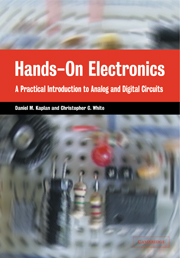Book contents
- Frontmatter
- Contents
- List of figures
- List of tables
- About the authors
- To the Reader
- Acknowledgments
- Introduction
- 1 Equipment familiarization: multimeter, breadboard, and oscilloscope
- 2 RC circuits
- 3 Diodes
- 4 Bipolar transistors
- 5 Transistors II: FETs
- 6 Transistors III: differential amplifier
- 7 Introduction to operational amplifiers
- 8 More op amp applications
- 9 Comparators and oscillators
- 10 Combinational logic
- 11 Flip-flops: saving a logic state
- 12 Monostables, counters, multiplexers, and RAM
- 13 Digital↔analog conversion
- Further reading
- Appendix A Equipment and supplies
- Appendix B Common abbreviations and circuit symbols
- Appendix C RC circuits: frequency-domain analysis
- Appendix D Pinouts
- Glossary of basic electrical and electronic terms
- Index
13 - Digital↔analog conversion
Published online by Cambridge University Press: 06 July 2010
- Frontmatter
- Contents
- List of figures
- List of tables
- About the authors
- To the Reader
- Acknowledgments
- Introduction
- 1 Equipment familiarization: multimeter, breadboard, and oscilloscope
- 2 RC circuits
- 3 Diodes
- 4 Bipolar transistors
- 5 Transistors II: FETs
- 6 Transistors III: differential amplifier
- 7 Introduction to operational amplifiers
- 8 More op amp applications
- 9 Comparators and oscillators
- 10 Combinational logic
- 11 Flip-flops: saving a logic state
- 12 Monostables, counters, multiplexers, and RAM
- 13 Digital↔analog conversion
- Further reading
- Appendix A Equipment and supplies
- Appendix B Common abbreviations and circuit symbols
- Appendix C RC circuits: frequency-domain analysis
- Appendix D Pinouts
- Glossary of basic electrical and electronic terms
- Index
Summary
In this chapter we will study simple techniques for generating and reading voltage or current levels, i.e., converting between analog (voltage or current) and digital (binary-number) information. The availability of high speed, easy-to-use, inexpensive digital⇒analog and analog⇒digital converter chips has dramatically changed the way audio and video information are recorded and processed, as well as how computers are used in laboratory research and process control. The process of converting digital information into voltages or currents whose magnitudes are proportional to the digitally encoded numbers is called digital-to-analog (D/A) conversion. The reverse process is called analog-to-digital (A/D) conversion. The devices that carry out these conversions are called DACs and ADCs, respectively.
In this chapter, after building a simple DAC from a digital counter and an op amp, you will continue your exploration of analog/digital conversion by building a 4-bit tracking ADC. Having learned the basic operating principles, you'll use an ADC080x 8-bit successive-approximation A/D chip to digitize (i.e., convert to digital) an arbitrary AC signal. The original signal will then be re-created from the digitized data using a DAC080x D/A chip. This exercise will also allow you to explore the limitations of ADC and DAC operations.
Please be sure to work through these circuits in advance, otherwise it is highly unlikely that you will successfully complete the exercises in a timely fashion! Carefully study the manufacturer's data sheets which provide extensive details on operation and performance. As always, complete schematic diagrams significantly improve debugging efficiency.
- Type
- Chapter
- Information
- Hands-On ElectronicsA Practical Introduction to Analog and Digital Circuits, pp. 167 - 182Publisher: Cambridge University PressPrint publication year: 2003

